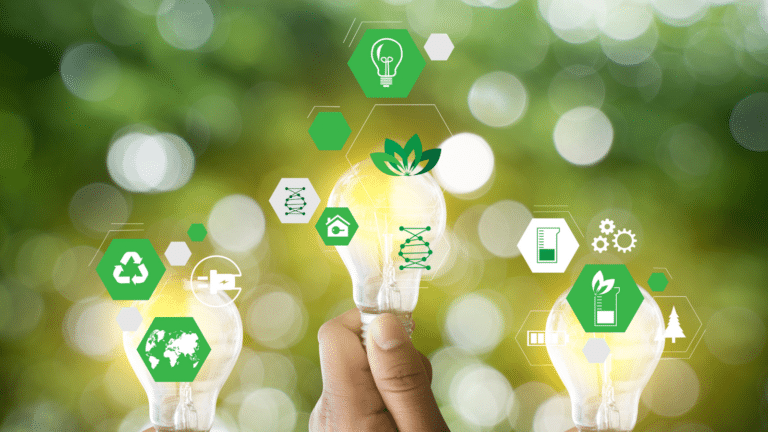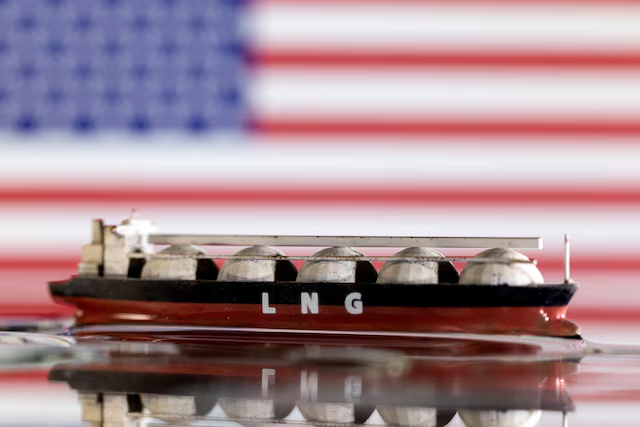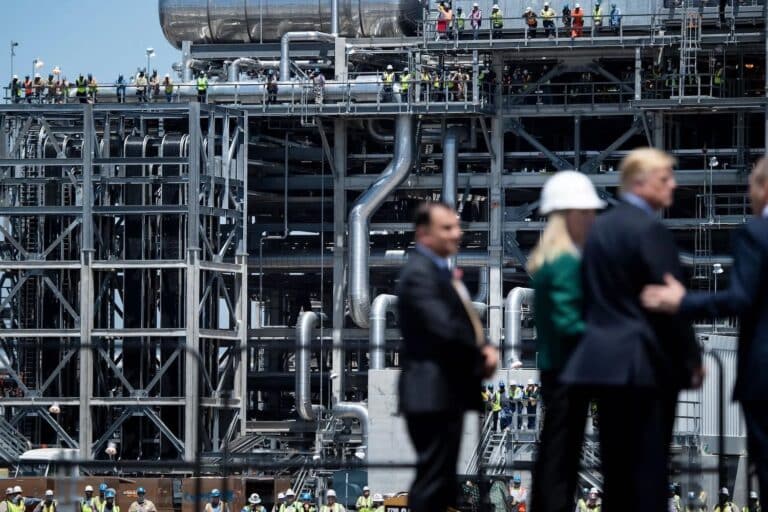This Energy Explained post represents the research and views of the author. It does not necessarily represent the views of the Center on Global Energy Policy. The piece may be subject to further revision. Contributions to SIPA for the benefit of CGEP are general use gifts, which gives the Center discretion in how it allocates these funds. Rare cases of sponsored projects are clearly indicated.
For a full list of financial supporters of the Center on Global Energy Policy at Columbia University SIPA, please visit our website at Our Partners. See below a list of members that are currently in CGEP’s Visionary Circle. This list is updated periodically.
Calls to “Drill, baby drill” are back with Donald Trump’s return to the White House, and for US natural gas production, the catchphrase might also be a necessity over the next three years if demand for the fuel grows as steeply as expected. New gas production will be required in the coming years to keep up with new liquefied natural gas (LNG) export projects and higher domestic use, whether it comes in the form of coal-to-gas substitution in a low-price environment or bustling data center demand in a high-price environment. However, if US gas production increases beyond the levels needed to feed these new projects, the question arises of what market and sector would receive the additional volumes of US gas and how should the use of gas be prioritized. US gas could serve Trump’s goal of energy dominance by being exported to Europe and Asia, or it could provide a low-cost domestic alternative to coal or other generating fuels to buttress economic growth. While the Trump administration may wish for gas to serve both purposes, it is also possible that choices will have to be made around which path is in the public interest.
US policymakers may now face a dilemma: Should policy efforts focus on creating more domestic or export-related opportunities to burn US gas? Domestic opportunities focus on supporting local gas use and local economies but may not necessarily appeal to gas producers that believe higher returns can be achieved overseas.
The Natural Gas Act (NGA) requires the Department of Energy (DOE) to consider the public interest when determining whether to allow natural gas exports.[1] The definition of public interest seems to be changing, however. The Trump administration has already revoked the pause on permitting LNG export projects from selling to non-free trade agreement (FTA) countries[2] and eliminated fees and penalties on excessive methane emissions in US gas production.[3][4] The consequences of these changes are far from certain, but are consistent with the loosely defined concepts of energy abundance and dominance, as they enhance the potential for more US LNG projects being fed by higher, if also more environmentally problematic, US gas production. The end of the LNG pause could lead to more US projects signing long-term take or pay contracts and making final investment decisions (FIDs), while US upstream will be able to produce more gas at a lower cost if methane emissions fees are eliminated.
Meeting LNG Demand Forecasts
The US gas market will need at least 13 billion cubic feet per day (Bcf/d) of additional gas production over the next three to four years just to feed the US LNG export projects already under construction, with the requirement for all new and existing plants expected to reach 26 Bcf/d by 2030.[5] This figure could grow by another 1-2 Bcf/d following the lifting of the US LNG pause if additional US and Mexican LNG facilities decide to go forward with projects.[6] In essence, Trump’s pro-fossil fuels stance could be seen as leaning into a commercial necessity, particularly in US gas basins adjacent to US LNG export projects. These basins are not only planning to produce more gas; they are also scrambling to build enough pipeline capacity to take this gas to the LNG export points where the feed gas is needed.
Until recently, US LNG exports were considered a savior for US gas producers looking to push more gas into a US market saturated with low-cost gas. Investments tied to industrial gas use had already taken place, and most additional US gas demand was emerging because of substitution tied to lower retiring legacy coal generation. Gas use would grow in the US power sector as long as it remained cheap enough to displace coal.
Supporting Domestic AI Power Demand or Increasing LNG Exports?
Artificial intelligence – and the potential boom it could cause in power consumption — has changed this dynamic for US gas. AI relies heavily on large-scale data centers for computational power. Electricity usage in data centers includes operations, training, inference, cooling systems, and storage.
While all forms of energy supply are being considered to power hyper-demand growth in AI, gas may be appealing given how inexpensive and regionally confined incremental US gas supply is throughout the continent and all the permitting and environmental issues usually associated with moving it. Goldman Sachs estimates that $50 billion in new generation capacity will be needed to meet demand from data centers and that about 3.3 Bcf/d of gas demand will be added by data centers by 2030.[7] Some large gas producers, such as EQT, with stranded gas reserves that cannot be exported estimate that data centers, particularly in Virginia, could end up needing up to 10 Bcf/d of demand 2030.[8] The wide difference between the Goldman Sachs and EQT estimates highlights the uncertainty around how energy-intensive data centers and AI will be. A recent study by Duke University suggests that a more efficient use of the current grid might require minimal impact while adding almost 100 GW of large loads.[9] It says load flexibility could be a critical tool to support economic growth while maintaining grid reliability and affordability.
How much additional gas could be needed depends on where the gas is located and, of course, how large the potential resource base is. Gas production in shale basins that cannot access markets due to constraints are ripe locations for AI development. These areas, such as the Marcellus and Utica shale basins in the US Northeast, have been looking for a demand-side outlet for years after attempts to connect with US Gulf Coast or other LNG export points (notably US East Coast locations) have failed due to permitting and environmental issues.
Key gas producers in the Marcellus basin claim they could double gas production if demand could be found.[10] Gas prices in areas such as the Northeast or portions of West Texas tend to be heavily depressed relative to the US benchmark at Henry Hub due to a lack of pipeline capacity to reach other regions. This trapped gas could generate power locally and feed low-cost sources of computing power.
There could be environmental benefits to building data centers close to gas production due to the short distance between supply and consumption. S&P Global has estimated that 40 percent of fugitive emissions come from the movement of gas by pipeline and the downstream use of gas in distant locations in areas for residential/commercial use, industry, power generation, and LNG production.[11] Consuming gas close to production could also reduce the need for flaring and venting in areas where gas is associated with production of crude oil and natural gas liquids. The lack of local- or export-oriented markets for gas tied to crude and NGL production has also played a leading role in curbing oil production growth. Crypto miners have already picked up on this local use case for gas in West Texas, using the fuel to create a competitive cost advantage in mining new coins, particularly when gas prices drop close to zero or are negative. AI gas consumption could be less sensitive to short-term market fluctuations and emerge as a baseload form of demand.
Somewhat paradoxically, permitting reform, a priority for both the Biden and Trump administrations, could undermine the value proposition for stranded gas in producing regions if more pipeline takeaway capacity can be built to link it to export-related opportunities. Current prices overseas of $14-15/MMBtu[12] are a siren song for US gas producers, but it is also not realistic to assume these returns are going to exist in perpetuity. Global LNG production is forecast to grow by 50 percent by the end of the decade, which will likely reduce overseas returns.[13]
So, while new gas production may be needed for anticipated new LNG projects, whether additional volumes are exported or consumed domestically remains unclear. The premise of placing more data centers and AI load in production areas was a method to utilize stranded gas that was constrained by a lack of midstream capacity to take it elsewhere. This potential demand was billed as a price support mechanism for producers struggling with cost issues. Now, data centers and AI load have the potential to be a competitive force in the marketplace, pinning demand in LNG export markets against these potential new areas for domestic use, which do not necessarily require low gas prices to work.
CGEP’s Visionary Circle
Corporate Partnerships
Occidental Petroleum
Tellurian
Foundations and Individual Donors
Anonymous
Anonymous
Aphorism Foundation
the bedari collective
Children’s Investment Fund Foundation
David Leuschen
Mike and Soa Segal
Kimberly and Scott Sheffield
Bernard and Anne Spitzer Charitable Trust
Ray Rothrock
[1] https://uscode.house.gov/view.xhtml?req=(title:15%20section:717%20edition:prelim)
[2] https://www.energy.gov/articles/us-department-energy-reverses-biden-lng-pause-restores-trump-energy-dominance-agenda#:~:text=Energy%20Dominance%20Agenda-,U.S.%20Department%20of%20Energy%20Reverses%20Biden%20LNG%20Pause%2C%20Restores%20Trump,and%20returning%20to%20regular%20order.&text=These%20Day%20One%20Actions%20will%20Return%20the%20Department%20to%20Regular%20Order
[3] https://thehill.com/policy/energy-environment/5168857-senate-repeal-methane-fee-implementation-rule/
[4] The Natural Gas Act (NGA) of 1938 primarily regulates the interstate transmission and sale of natural gas, focusing on rates and services to ensure fair practices and prevent monopolistic behaviors. It does not specifically address methane emissions. Methane emissions from the oil and gas sector are regulated under the Clean Air Act (CAA). Notably, the Inflation Reduction Act of 2022 introduced the Methane Emissions Reduction Program, which empowers the Environmental Protection Agency (EPA) to implement measures aimed at reducing methane emissions in this sector. This program includes financial and technical assistance, as well as a Waste Emissions Charge (WEC) on facilities that exceed specified methane emission thresholds.
[5] https://www.eia.gov/todayinenergy/detail.php?id=62984.. Typically, 8-10% of the original gas energy is consumed to power the liquefaction process (e.g., running compressors and refrigeration systems).
[6] https://www.bnamericas.com/en/analysis/mexico-pacific-plans-saguaro-energia-final-investment-decision-this-year
[7] https://www.goldmansachs.com/insights/articles/AI-poised-to-drive-160-increase-in-power-demand
[8] https://oilprice.com/Energy/Natural-Gas/EQT-Sees-Strong-Data-Center-Driven-Gas-Demand-Growth-by-2030.html#:~:text=Data%20centers%2C%20particularly%20in%20Virginia,energy%20demands%20of%20data%20centers
[9] https://nicholasinstitute.duke.edu/articles/three-key-takeaways-rethinking-load-growth-us-power-systems
[11] https://press.spglobal.com/2022-12-14-Higher-Natural-Gas-Prices-Have-Made-Methane-Capture-Projects-Increasingly-Economic,-Potentially-Unlocking-Vast-Amounts-of-New-Supply-While-Lowering-Overall-Emissions
[12] https://www.cmegroup.com/markets/energy/natural-gas/lng-japan-korea-marker-platts-swap.html and https://www.cmegroup.com/markets/energy/natural-gas/dutch-ttf-natural-gas-usd-mmbtu-icis-heren-front-month.html
[13] https://www.energypolicy.columbia.edu/lng-capacity-in-search-of-gas-production/









